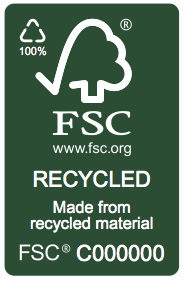 This post is intended to be the last in our short informational series about wood product chain of custody (CoC) certification. The series is devoted to a simple idea: chain of custody (CoC) should NOT be complicated. This final installment addresses the interaction between conventional “green” claims of sustainability for virgin, forest-based wood products and the “also-green” claims associated with recycled content (RC) materials.
This post is intended to be the last in our short informational series about wood product chain of custody (CoC) certification. The series is devoted to a simple idea: chain of custody (CoC) should NOT be complicated. This final installment addresses the interaction between conventional “green” claims of sustainability for virgin, forest-based wood products and the “also-green” claims associated with recycled content (RC) materials.
How does RC fit into CoC?
In the early days of Sustainable Forest Management (SFM) certification, the subject of recycling wasn’t even considered. FSC, SFI, & PEFC were all conceived and designed – first of all – to promote the responsible and sustainable management of forests. CoC systems were added later with the specific purpose of providing a credible and marketable connection between the hard work being done in the forest and finished, forest-based products in the world’s retail & wholesale markets. Recycled wood products didn’t come from forests – at least not directly. So they didn’t seem relevant.
It wasn’t long before a problem emerged. The problem was that recycling and recycled products had been promoted as a positive, “green” practice for many years. When consumers were presented with a choice between certified, virgin products, on the one hand; and uncertified, recycled products; they were confused. In truth, everyone was confused. The apparently simple question: which is better? just didn’t have a simple answer. And the young SFM certification standards quickly began to compete with established, recycled claims – particularly in the important paper markets. All three of our CoC standards reacted by recognizing recycled content as essentially similar to virgin, certified content; and practical rules were developed to manage the details.
Some Definitions: Pre- vs. Post-
The recycling business has become an industry unto itself. And like any industry, it has its own nomenclature and terminology. Here in the US, the Federal Environmental Protection Agency provides a good, central source of information on the subject. For our purposes, recycled material falls into two, well-recognized categories: Pre-consumer and Post-consumer. Here is an excerpt from the definitions section of the FSC standard:
This language is virtually identical to similar definitions found in the ISO guidance on environmental claims (ISO 14021:1999). Fortunately for all of us, SFI and PEFC also followed this guidance, and their definitions are essentially identical. We commonly explain it this way: Pre-consumer material is manufacturing waste. Post-consumer material comes from households, offices, and other municipal trash collections.
The Details
The flowchart to the right outlines how the the three CoC standards recognize RC material as inputs.
PEFC takes the simplest approach. Their definition of “certified content” (found in Annex 1 of the PEFC ST 2002:2013 standard) includes all recycled content – without distinguishing between Pre- and Post-consumer categories.
The SFI standard does make a distinction between Pre- and Post-consumer content, and includes guidance directing users to refer to legal standards on the subject. The CoC standard includes references to recycled inputs, but they are incomplete and rather confusing – leaving users, certifiers, and consultants (like us) to interpret creatively. It works in practice, but is a bit messy.
The FSC program (as usual) takes the most complex approach. Although the same categories are used, they do not rely on everyday marketing practices to sort and designate material. Instead, they provide their own standard (FSC-40-007 v.2-0) for acquiring RC inputs. It is a simple standard in practice, but necessary if you want to use RC material in a FSC product. As a client once remarked, “It ain’t recycled until FSC says its recycled!”
Even though neither FSC nor SFI recognize Pre-consumer RC material as equivalent to certified, virgin material; this material still has significant status. Recycled materials are specifically exempted by all the programs (including PEFC) from the Due Diligence System (DDS) requirements discussed in Part 4 of this series. This means that RC inputs can be treated as “eligible inputs”, having essentially the same status as “FSC Controlled Wood”, “PEFC Controlled Sources”, and “SFI Certified Sourcing”.
Claims and Sales
When CoC products containing recycled content are sold, the programs vary somewhat in how transparent the final CoC claim is required to be.
FSC products that contain no virgin content at all are always sold with the specific “FSC Recycled” claim and label (see the example at the top of this post). Products that contain any virgin content at all – even a tiny amount – must be sold with the catch-all “FSC Mix” claim. This would apply to a 99% recycled product or even an all-virgin product produced by a complex CoC system (% or credit). This last case is – in our experience – surprisingly common, and (in our opinion) not transparent at all.
SFI systems that use percentage-based claims are required to disclose Post-consumer content, but not Pre-consumer content. In practice, however, this information is often hidden from view, making the product claim just as opaque, in practice, as the FSC products.
PEFC uses but a single claim and a matching label type: “PEFC certified”. Because their system recognizes all RC material as “certified”, a consumer has no specific access to the relative proportions of RC versus virgin content. I am told that this distinction is less important in Europe where these claims are more common. Here in North America, recycled content is still sought after by green marketers.
Some Future Trends
The disparity over treatment of Pre-consumer RC between FSC & SFI, on the one hand, and PEFC on the other; is an important one. Pre-consumer RC material is a large and important commodity product – particularly in the paper packaging business. A formal discussion process is underway at FSC, looking into the possibility of following PEFC on this point. SFI staff have told me that this subject was also raised during their ongoing standard update process this year. We should know soon whether to expect a change in the coming year.
Here to Stay
In the early days, CoC certification was widely described as a means by  which a certified and labelled product on a store shelf could be traced all the way back to a tree growing in a certified forest. This made a nice-sounding story and I still hear it repeated from time to time today. Now, however, it is a bit more complicated. CoC does provide tracing back to the source. But the source might well be a trash can – making the story a little less “warm and fuzzy.”
which a certified and labelled product on a store shelf could be traced all the way back to a tree growing in a certified forest. This made a nice-sounding story and I still hear it repeated from time to time today. Now, however, it is a bit more complicated. CoC does provide tracing back to the source. But the source might well be a trash can – making the story a little less “warm and fuzzy.”
The question about whether recycled wood products are “better” or “as good as” certified, virgin products is a complex one. The answer won’t be simple and will vary with markets, geography, politics, and maybe even climate. If you are interesting in exploring this subject further, I recommend this paper by The Dovetail Partners.
One way or another, we will be including RC products and materials in the business of “green” certification for the foreseeable future. Fortunately, the standards have stayed pretty well aligned and – comparatively speaking – pretty straightforward. Because – CHAIN OF CUSTODY SHOULD BE EASY! – shouldn’t it?
